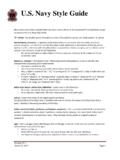Transcription of Community Garden Guide - USDA
1 1 Community Garden Guide Vegetable Garden Planning and Development Rose Lake Plant Materials Center 7472 Stoll Rd. East Lansing, MI 48823-9420 Telephone: (517) 641-6300 Fax: (517)641-6300 2 New Garden Preparation Site Selection Choosing the Garden site is very important. The site should receive at least 6 hours of direct sunlight (although the more light the better). The site should also be near a water supply and accessible to the gardeners. Loam soil is most desirable. If the Garden site does not have loam, the soil structure can be modified over time by adding compost or organic matter.
2 The site should also be free from rubble and debris, should be relatively free of pollutants and away from pollution sources. Garden Shape, Preparation and Row Orientation Garden Shape The shape of a Garden area can have an effect on how easy it is to manage. If the Garden area is to be tilled and cultivated each year with a power tiller, consider a rectangular shaped Garden . A longer Garden means less turning and re-aligning of the tiller. Gardens that will be worked only by hand tools may be square in shape. If the Garden site has shape limitations then a compromise between efficient use of space and ease of tilling must be made.
3 Figure 1. Options for Garden shape 30 ft x 30 ft 900 sq. ft 20 ft x 40 ft 800 sq. ft Preparation - Double Digging Double digging is an extremely labor intensive technique that can be used to prepare a small Garden site and is most effective on heavier loam or clay soils. Preparing a Garden site in this manner will maximize rooting depths of plants and enhance percolation of water through the soil. The technique consists of digging a trench about 8-10 inches deep across one end of the Garden (trench A below).
4 Place this top soil at opposite end of the Garden . It will later be used to fill the last trench. Loosen the soil in the bottom of the newly dug trench to a depth of 8-10 inches. Incorporate organic matter/compost into the trench. Dig a new trench (trench B below) immediately next to the first trench and deposit the top soil into the first trench. Continue this process until the entire Garden site has been tilled. Place the top soil from the first trench into the last trench (trench G below) after the bottom soil in the trench is prepared. 3 Figure 2.
5 Double Digging The double digging technique is not recommended for sandy soils as they generally allow good root penetration. Incorporation of organic materials such as compost or green manure crops will benefit sandier soils by increasing moisture retention in the soil. Broad Forks Broad Forks are soil preparation tools that provide good seedbed preparation for small gardens while minimizing mixing of the soil layers. The tines of the tool are pushed into the ground and rotated backwards, breaking up and loosening the soil. Figure 3. Broad Fork Preparation-Direct Tillage A new Garden site can be successfully developed by direct tilling the existing sod.
6 Initial site preparation can include moldboard plowing the site followed by rototilling. The soil must not be wet during any tillage operation. Tilling wet soil will damage the soil structure, affecting the soil s productivity. Garden sites can also be successfully developed by rototilling alone. Creating a Garden site in an area of existing sod cover will require multiple passes of the rototiller. In general a 5 HP tiller, as a minimum, will be required. The initial tillage pass should be shallow, approximately 1-2 inches deep. Subsequent passes of about 2 inches in depth should be performed until the soil is tilled to a depth of 6-8 inches.
7 Row Orientation 4 Till-less Garden Till-less gardens can be an effective method for developing a new Garden site. In general this method is reserved for smaller Garden areas because of increased labor requirements and higher initial costs. Try to select a site that has good soil conditions as described above. A till-less Garden is just what the name implies the Garden soil is left undisturbed during initial establishment of the Garden . 1. Begin by mowing all vegetation as close to the ground as possible. 2. Place newspapers 10-15 pages thick directly over the mowed area.
8 Be sure to overlap the newspapers 3-4 inches to prevent weeds from growing between the pages. 3. Spread compost, top soil or well-rotted manure to a depth of 4-6 inches over the entire newspaper area. 4. Plant Garden seeds in the prepared Garden bed. Depending on the source of topsoil or rotted manure, there may be weed issues to deal with during the first year of establishing a till-less Garden . Solarization, mulch and/or cover crops can be used to reduce weed pressure. Planting the new Garden site to fast growing, large-leafed, shade-producing plants such as pumpkins or winter squash can help suppress weeds.
9 Garden Sizing Some gardeners prepare a Garden site and size it based on available space. Gardens can also be sized to accommodate production of an estimated amount of food a family will consume in a year (Tables1, 2 and 3). If Garden space is limited or if there is uncertainty on how large of a Garden to make, it may be useful to calculate the Garden area required based on vegetable production goals. Tables 1 and 2 provide information and a procedure for determining Garden size. Plan a mix of vegetable varieties and space allocation in the Garden to suit personal preferences and quantities of produce desired.
10 Soil Test Soil testing of the Garden site is essential. Soil tests provide valuable information about fertility and pH and provide the basis for fertilizer and liming recommendations. Plan on soil testing the season before the Garden is planted, preferably before the ground freezes. This allows for planning of fall applications of nutrients and lime to prepare the Garden site for spring planting. Another benefit of fall testing is that fertilizer prices are more likely to be discounted during that season. Information about how to take a soil test and costs are usually available from your County Cooperative Extension Office.



















